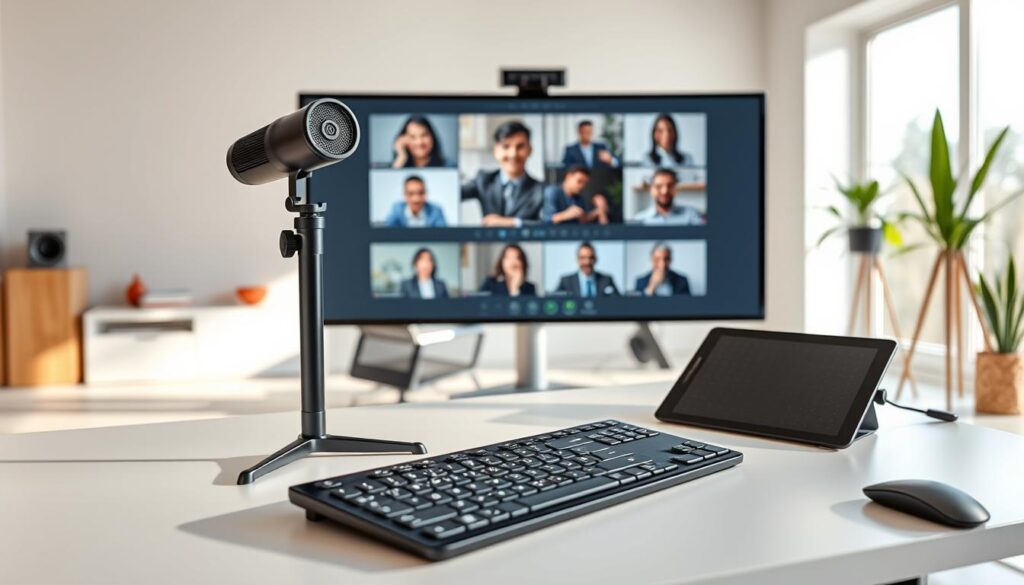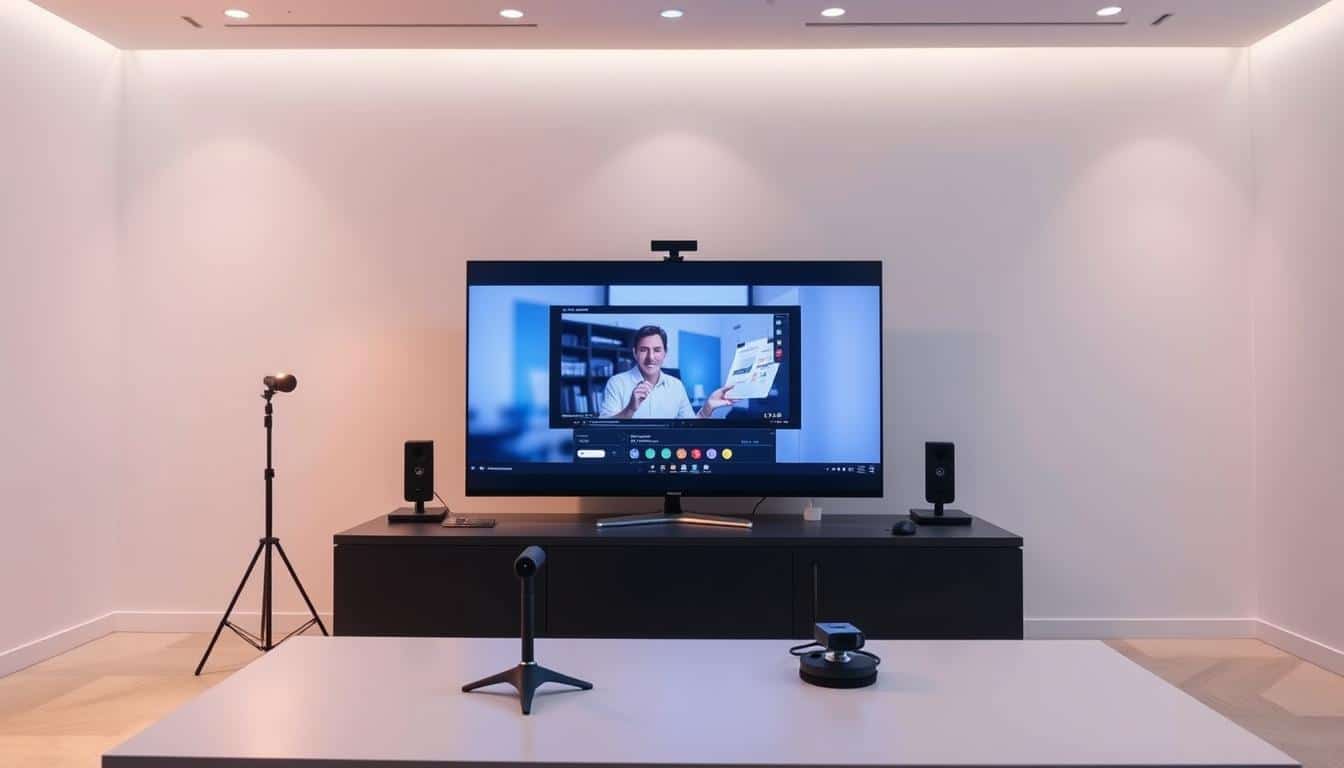Today’s work world is all about the power of digital meet-ups. As remote work becomes the norm, digital platforms are key for team connections. This guide will share how to make virtual meetings better. We aim to make your discussions lively and useful. By improving your virtual meeting space, teamwork and results will get a big boost.
Anúncios
Understanding the Importance of Virtual Meetings
Virtual meetings are key in today’s work world. They help people communicate and work together from different places. This flexibility lets teams talk with colleagues, clients, and stakeholders everywhere.
Virtual meeting platforms have advanced features. These include real-time translation and gesture recognition, making discussions more engaging. Noise cancellation also makes the audio clearer. These tools make sure that everyone can participate fully.
Being able to record meetings and get automatic transcriptions is very helpful. It keeps important details and boosts productivity. This means less note-taking and more transparency for teams.
Virtual meetings also save money. They reduce travel and venue costs, so businesses can use their money more wisely. Not having to travel saves time and keeps teams working well together.
These meetings welcome all types of participants, whether joining by audio or video. This supports different team needs and makes sure everyone can join in. Understanding the benefits of virtual meetings helps companies perform better and improve their work-life balance.
The Definition of a Virtual Meeting
A virtual meeting lets people talk and work together online instead of meeting in person. This way, people from different places can easily communicate and work together. Platforms like Zoom, Skype, and Microsoft Teams make it possible for people to join these meetings using phones or computers.
During these meetings, attendees can share their screens, documents, and presentations. This makes working together from afar much better. Virtual meetings come in different types like video calls, audio chats, and text conversations. They make it easy for everyone to communicate in the way they prefer. These meetings remove distance problems, so no one has to travel to join.
Virtual meetings are great because they include everyone, no matter where they are. This way, teams can share ideas and move projects ahead without the problems of having to meet in person.
Types of Virtual Meetings
Knowing the different types of virtual meetings can boost engagement and teamwork. Each one is special, designed for certain needs, making sure everyone can join in well. Main types are video conferencing, web conferencing, webinars, teleconferencing, and huddles. We’ll look into each one below.
Video Conferencing
Video conferencing brings people together with real-time video, helping teams bond and work together. Using apps like Zoom and Microsoft Teams offers clear video and sound, rooms for small groups, and screen sharing. These features help users see gestures and talk almost like they’re in the same room.
Web Conferencing
Web conferencing is great for interactive work like presentations and team projects. It boosts work efficiency with screen sharing and whiteboarding for brainstorming and team tasks. The main benefits are better communication and access, allowing teams to work smoothly from different places.
Webinars
Webinars are mainly for teaching and sharing information, fitting well for training or spreading news. They usually have many viewers and one key speaker. Companies and schools use webinars to deliver valuable info and keep participants involved with questions and voting.
Teleconferencing
Teleconferencing, an audio-only choice, is good for quick talks in small groups. It lets people join calls without video, perfect when internet is slow. It offers an easy way for important chats that don’t need visuals.
Huddles
Huddles are for easy, quick team talks, allowing for rapid updates or check-ins. These brief meetings help teams connect and work well together. Using tools like Slack for huddles makes talking simple and fast, an excellent tool for any group’s daily plans.
Why People Use Virtual Meetings
Now, over 75% of people meet online at least twice a month. This shows how popular virtual meetings are becoming. People enjoy virtual meetings because they are easy to join, save money, and are efficient. These meetings are great for different things like training, interviews, updates, and planning.
Online meetings save a lot of money because there’s no need to travel or pay for places to stay. People can do more important work instead of traveling. They let people from all over the world meet easily.
Virtual meetings make work easier by sharing screens and working together in real time. They also help the planet by cutting down on travel. Plus, they make it easier for different people to work together. With 70% of workers feeling less stressed in online meetings, it’s clear they help balance work and personal life. From 2020 to 2022, the use of virtual meetings jumped from 48% to 77%. This shows how important they are in business today.
Benefits and Drawbacks of Virtual Meetings
Virtual meetings have their good and bad sides. They offer advantages of virtual meetings but also have clear disadvantages of online meetings. Knowing both helps us use remote meetings better in business.
Pros of Virtual Meetings
Virtual meetings save a lot of money and time. You don’t have to travel or set up a meeting room. People can join from anywhere, making more folks likely to attend.
Recordings let people watch later, helping them learn and remember more. Better ways to communicate help teams work better together.
Cons of Virtual Meetings
There are downsides to virtual meetings, too. Not being together in person can make it hard to build trust.
It’s tough to manage big groups online. You can’t see how people are feeling without seeing their faces. Bad internet can stop a meeting in its tracks, and different time zones make planning hard.
We also have to be careful about keeping our meetings private and safe online.
Best Practices for Hosting Effective Virtual Meetings
Running successful virtual meetings needs good planning and action. By using effective practices, you can boost productivity and keep everyone involved. Here are top tips for making online meetings work well.
Share the Agenda in Advance
It’s helpful to give everyone the meeting agenda early. This way, they can prepare and know what to expect. An organized agenda leads to better focus and makes sure everyone knows their role.
Encourage Participation
Getting people to take part is key in virtual meetings. Use tools like polls or split groups to make things interactive. Making sure everyone can share their thoughts helps include all viewpoints. Starting with something fun like icebreakers helps everyone feel connected.
Assign Roles Ahead of Time
Having certain roles, like someone to lead and another to take notes, makes things run smoother. Knowing who does what keeps the meeting on track. This makes sure important points are remembered later. Following these guidelines will make your virtual meetings more effective and focused.
Virtual Meeting Setup for Optimal Results
For the best virtual meeting setup, we need to focus on key areas, from choosing the right tech to organizing our space. Using platforms like Google Hangouts Meet makes setting up easier. It offers mobile support, chat options, and simple screen sharing. These features help everyone join smoothly, from laptops or smartphones.
Planning ahead with tools like Google Calendar is crucial. A detailed invite with an agenda should be sent out at least 15 minutes before. This lets participants get ready in advance. Doing so, along with expecting replies, leads to more effective meetings.
Good communication relies on the right tools to boost productivity. Asana helps keep the team updated on tasks, while Wrike is great for in-depth reports. These tools help list tasks, deadlines, and who is responsible. This makes tracking progress easy.
Being able to join a meeting from any device is a big plus. Leaders should check the internet connection and test the audio/video beforehand. They should also prepare interactive tools like polls. This helps make meetings run smoothly and keeps everyone engaged.
An organized meeting area makes a big difference. Choose a quiet spot without interruptions and use noise-cancelling headphones. Starting on time and sticking to the agenda shows respect for everyone’s time. This helps keep discussions productive.
Breakout rooms are useful for smaller group talks. They help quieter people share their thoughts. Writing down main points and decisions during the meeting ensures everyone agrees. Sending out the meeting notes afterward keeps everyone informed about what needs to be done.
In summary, setting up a virtual meeting the right way takes planning and action. By following these tips, we can work together better. We don’t even need to travel, which saves time and boosts our work.
Interactive Strategies for Engagement
Making virtual meetings engaging is key for teamwork and active involvement. By using interactive methods, organizers can make the environment lively. This approach encourages everyone to participate and makes meetings unforgettable.
Use Interactive Tools and Features
Using advanced tools makes virtual meetings more interactive. Here are some ideas to consider:
- Incorporate games, quizzes, and polls to encourage active engagement.
- Leverage platforms like Kumospace for immersive experiences and enhanced interaction.
- Use visual aids such as slide decks and virtual whiteboards to make discussions more engaging.
- Collect real-time feedback through polls and surveys to gauge understanding and opinions.
- Create personalized agendas that allow attendees to select sessions based on their interests, increasing relevance.
Implement Icebreaker Activities
Starting with icebreaker activities makes virtual meetings more welcoming. Here are some ideas:
- Ask fun icebreaker questions like: “What is the most adventurous thing you’ve ever done?” or “If you could have dinner with anyone, living or dead, who would it be and why?”
- Implement quick-fire question rounds to energize the meeting and stimulate quick thinking.
- Encourage introductions followed by icebreaker questions to foster a welcoming environment.
- Assign a meeting facilitator to manage the flow and ensure everyone has a chance to contribute.
Identifying Technology Requirements
Choosing the right technology for online meetings is key to good communication and teamwork. It’s important to check that your meeting platform has all the features you need. Think about the following important points:
- Screen-Sharing Capabilities: This lets people share their screens to present content and work together better.
- Virtual Backgrounds: Virtual backgrounds make things look more professional and less distracting.
- AI-Driven Features: Tools like transcription, noise reduction, and face recognition can make meetings better and easier to join.
- Bandwidth Requirements: The right bandwidth keeps video and audio clear.
- Security Measures: Passwords, encryption, and monitoring keep information safe.
- Mobile Endpoints: Being able to plug and play supports work both in and out of the office.
- Integration Options: Integrating systems can make video meetings work smoother and be more functional.
Knowing how to use tools like Microsoft Teams, Zoom, and Google Meet is a must. Microsoft Teams’ Together Mode makes meetings feel like everyone’s in the same room. Also, consider getting good cameras and mics for clearer sound and picture. Apps like Miro and Trello increase productivity by helping with brainstorming and managing projects.
Lastly, keeping your software up to date, having tech support, and using room booking software makes everything run smoothly. This ensures spaces are used well and technology is always ready. Making these a priority improves online meetings for everyone.

Creating a Productive Meeting Environment
Setting up a good virtual meeting space is key for great communication and teamwork. The right lighting, a clean background, and where your camera sits can really draw people in. Bright lights keep distractions low, and a neat space shows you’re serious. Try to have your camera at eye level to better connect with everyone.
How your meeting area is arranged is important to keep focus. Remove any loud background noises and pick a spot that lets others know you’re not to be disturbed. Before your meeting begins, check your tech to make sure everything’s working right. Being prepared in this way makes virtual meetings run smoothly without any hiccups.
Having clear rules helps keep discussions organized. Tell everyone what you expect, like muting when not talking and asking questions in the chat. These guidelines boost involvement and let everyone have their say, making meetings more lively.
Screen sharing can be tricky, especially when you can’t see the speaker because the screen changes. Look into what your software can do, like keeping everyone visible while sharing screens. Another idea is using a second device to watch the presenter and still see the shared material.
Try not to have meetings during lunch or after normal work hours. It’s best to start on a regular schedule, maybe ten minutes after the hour for long ones and five minutes for short meetings. Planning meetings when people are most alert and ready helps everyone do their best.
Conclusion
Understanding how to set up virtual meetings is key for better communication in teams. These meetings are very important for working together, but often issues like not planning ahead and too many meetings reduce their effectiveness. By having a clear plan and cutting down on unnecessary meetings, businesses can use virtual meetings to increase work productivity.
Looking at the best ways to do virtual meetings, using interactive tools like Gather helps people feel connected. This connection is important to help remote workers not feel alone. By asking for feedback and promoting open conversations, businesses can make their teams work better together and achieve more.
As companies keep adjusting to remote work, making virtual meetings better is more important than ever. By having open talks, making sure everyone knows their responsibilities, and having clear next steps, teams can use virtual meetings to spark new ideas and success.
FAQ
What is a virtual meeting?
Why are virtual meetings important in the workplace?
What types of virtual meetings exist?
What are some best practices for hosting effective virtual meetings?
How can I enhance engagement during virtual meetings?
What technology should I use for virtual meetings?
What should I consider when creating a productive meeting environment?
What are the main advantages of virtual meetings?
Are there any drawbacks to virtual meetings?
Conteúdo criado com auxílio de Inteligência Artificial



